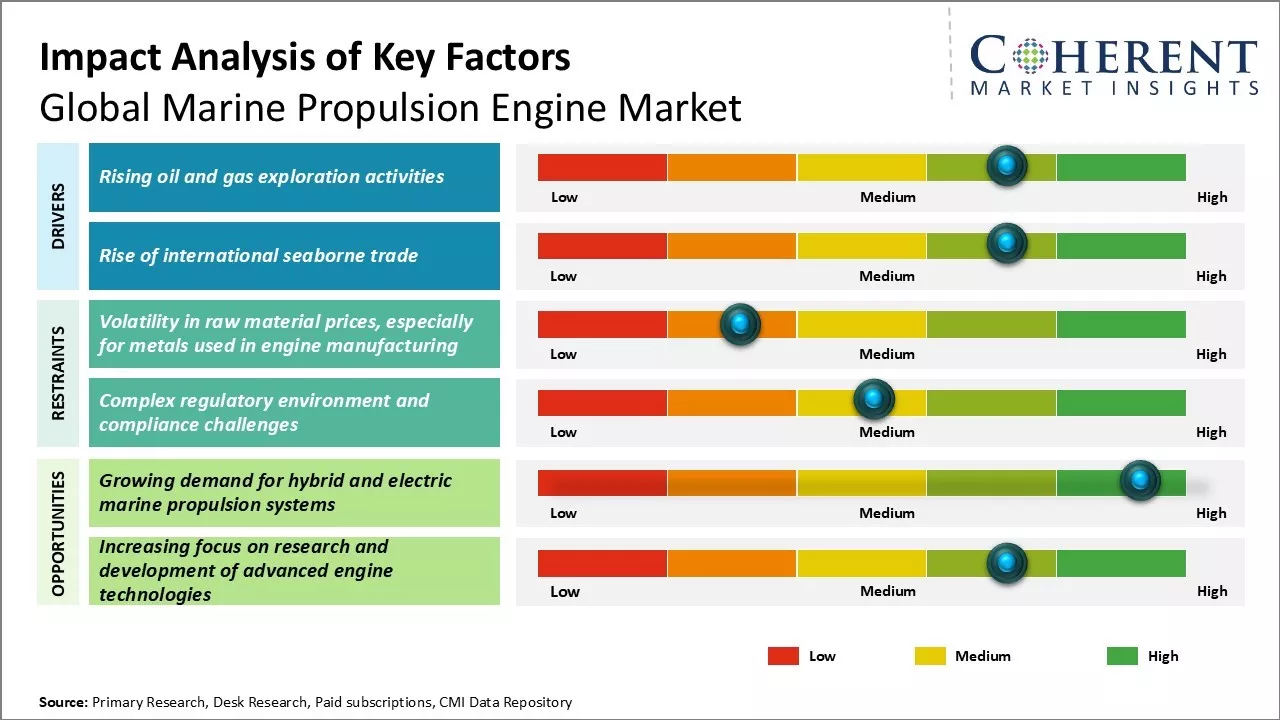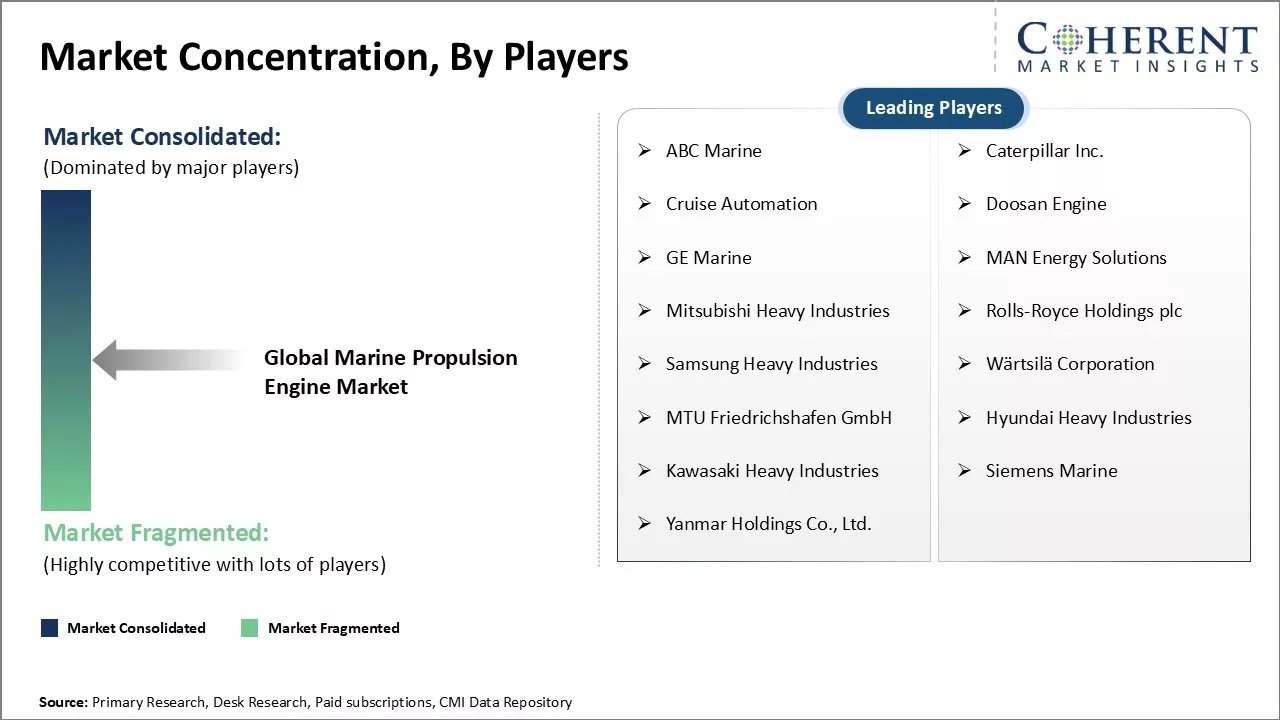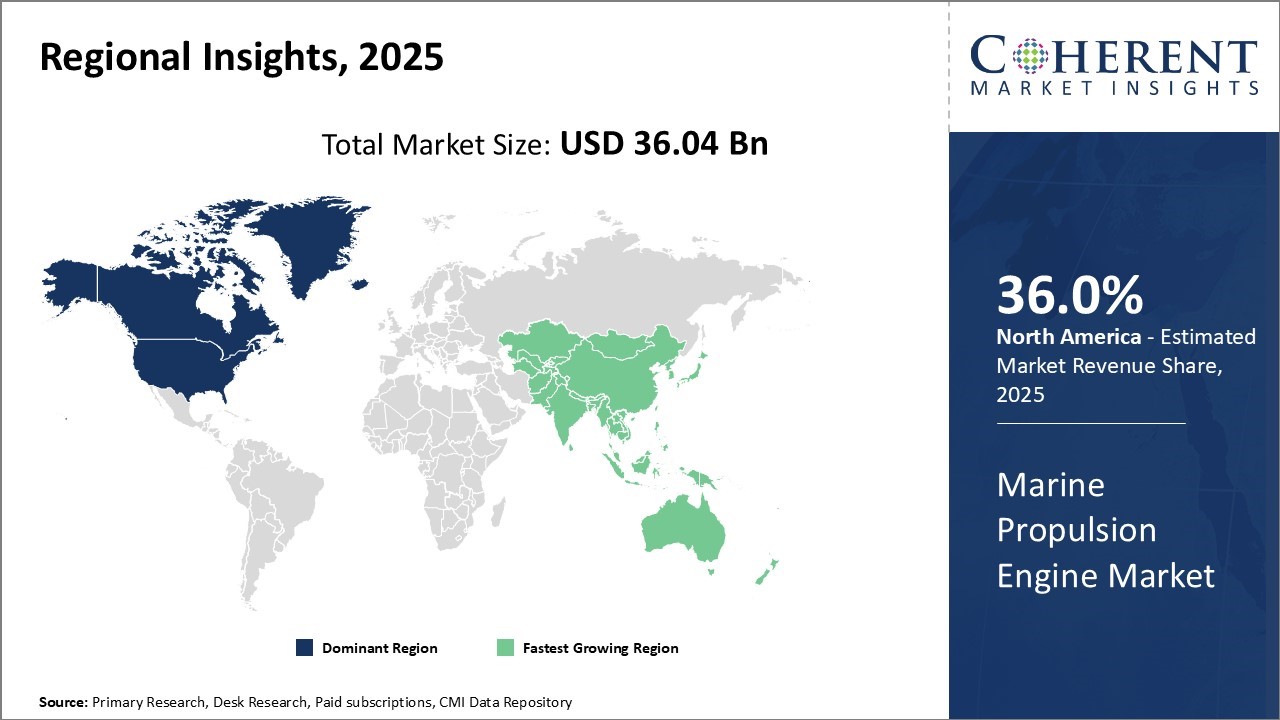The Global Marine Propulsion Engine Market is estimated to be valued at USD 36.04 Bn in 2025 and is expected to reach USD 47.78 Bn by 2032, exhibiting a compound annual growth rate (CAGR) of 4.1% from 2025 to 2032.

To learn more about this report, Download Free Sample
The demand for new marine vessels is propelled by the increasing international seaborne trade and growing cruise tourism. This, for instance, has resulted in the global surge of cruise passengers, which, in turn, has resulted in greater demand for advanced propulsion engines. In addition, the marine propulsion engine manufacturers are being pushed to develop low-emission and fuel-efficient engines, due to the growing emphasis on environmentally friendly engines. In combination, these trends are anticipated to support the marine propulsion engines adoption till 2032, reinforcing market growth in light of the environmental regulations.
|
Event |
Description and Impact |
|
Global Maritime Decarbonization and IMO 2030/2050 Emissions Targets |
|
|
Global Supply Chain Disruptions and Raw Material Shortages |
|
|
Geopolitical Tensions and Regional Maritime Security |
|
Uncover macros and micros vetted on 75+ parameters: Get instant access to report
The marine propulsion engine industry is witnessing a radical transition thanks to AI, which is enhancing practicality, dependability, and eco-friendliness. It makes predictive maintenance possible by examining real-time engine data, which in turn diminishes the duration of maintenance and boosts the lifespan of the machines. AI further refines the fuel consumption by changing the parameters according to the ship's speed, climate, and water conditions.
For instance, in May 2025, South Korea’s titan HD Hyundai Heavy Industries (HHI) partnered with the US-based software development company Altair to enhance the performance of eco-friendly marine engines and explore the potential of artificial intelligence (AI) in the maritime industry.

To learn more about this report, Download Free Sample
With global energy demands increasing every year, more oil and gas exploration projects are being undertaken across the world. Remote and offshore oil rigs require marine vessels equipped with powerful marine propulsion engines to transport equipment, materials, and personnel to these sites.
As exploration moves to deeper waters and more remote locations, specialized marine vessels are being used which increases the demand for high-powered marine propulsion systems. Major energy companies are investing heavily in offshore oil and gas exploration, especially in regions like the Middle East, Africa and Asia Pacific.
This is driving the need for Offshore Support Vessels (OSVs), Platform Supply Vessels (PSVs), Anchor Handling Tug Supply vessels (AHTS) and others which rely on efficient diesel engines and hybrid systems for marine propulsion. The growing complexity of offshore projects means marine equipment needs to function under extreme conditions with reliability, further supporting the marine propulsion engine market.
With globalization in full swing, international trade volumes have grown exponentially over the past few decades. A massive percentage of this cargo is transported via ocean freight through ships and vessels. Container ships, tankers, bulk carriers and other merchant vessels transport raw materials, parts, components and finished goods across continents. As global population rises and emerging economies industrialize at a rapid pace, demand for consumer and industrial goods increases steadily.
This translates to higher cargo volumes handled by the shipping industry. New destinations and ports are being developed around the world to cater to this growth. Bigger ships are being constructed that require more powerful marine engines to achieve higher speeds and efficiencies. Naval architects are designing vessels that can navigate shallower drafts as well with manoeuvrability.
All these developments mean enhanced demand for upgraded marine propulsion solutions that can deliver reliability, endurance, and optimized performance even in congested waters. Established shipping routes are also seeing increased freight densities necessitating faster turnaround times, again propelling the marine propulsion engine and equipment business.
The global marine propulsion engine market has a huge opportunity in the growing demand for hybrid and electric marine propulsion systems. With growing environmental awareness and stringent emission norms, ship owners and operators are inclined towards greener technologies. Hybrid and electric systems are gaining popularity as they offer several benefits like low maintenance, high fuel efficiency, and negligible emissions.
These environment-friendly engines are ideal for passenger and cargo vessels engaged in short-distance maritime transportation. With technological advancements, the operational range of electric vessels is increasing steadily, offering greater feasibility. Leading engine manufacturers are proactively developing hybrid and electric product variants.
They are also receiving favorable government policies and incentives for eco-friendly marine initiatives. This shifts the market dynamics in favor of alternate propulsion systems and generates massive business prospects.
Diesel engines contribute the 54.8% share of the global marine propulsion engine market in 2025 owing to their reliability and efficiency. Diesel engines have been the workhorse of marine propulsion for decades due to their ability to deliver high power outputs even under heavy loads for extended periods of time. Ship owners and operators have come to rely on diesel engines to power their fleets in a cost-effective manner without compromising on performance.
Diesel engines offer various advantages over other engine types. They are highly fuel efficient, with typical fuel consumption rates 20-30% lower than alternatives. This directly reduces operating costs for shipowners. Diesel engines also require relatively inexpensive heavy fuel oil as fuel, keeping fuel costs low. Their mechanical design is simpler than gas turbines, requiring less maintenance and downtime. Reliability is extremely high even in punishing marine environments with saltwater, moisture and vibrations. This reliability and uptime are crucial for shipping operations.
Manufacturers have also continually improved diesel engine technology. The introduction of common rail fuel injection systems and electronic engine management has boosted efficiency and power output. Emission regulations have led to the adoption of exhaust gas recirculation and selective catalytic reduction systems, allowing diesel engines to meet stringent environmental standards. Automation has decreased manning requirements. These advancements have cemented diesels as the first choice for marine propulsion.
With established global supply chains and experienced shipbuilding yards, diesel engines also benefit from economies of scale in their production. This allows aggressive pricing without compromising on quality. As a result, diesel engines capture the highest share across sectors such as tankers, bulk carriers and container ships that prioritize workhorse propulsion for international voyages. Their reliability makes them dominant in the global marine propulsion engine market.
The segment of engines with power output less than 10,000 kW captures the 43.6% share of the global marine propulsion engine market in 2025. This is driven by the need for propulsion systems with low initial and operating costs that are suitable for smaller vessels.
Engines in the less than 10,000 kW range are often used to power coastal and inland waterway vessels such as tugs, offshore support vessels, fishing trawlers and ferries. These vessels have smaller hull sizes and lower cargo volumes compared to ocean-going carriers. Their operations involve shorter distances, turnarounds in ports and higher maneuvering needs near coastlines.
Given their operating profile, lower capital and running costs take priority over ultra-high power outputs. Engine manufacturers optimize designs in this segment for affordable pricing, fuel efficiency and easy maintenance tailored to smaller shipyards. They are also compact with a higher power-to-weight ratio for maneuverable installations.
Operating expenditures, mainly fuel costs, constitute a major portion of the total cost for owners and operators in this sector. Lower power engines in the range of a few thousand kW consume less fuel. They also have maintenance schedules aligned to uptime requirements for coastal operations rather than long transits. This significantly reduces operational expenses.
The price points of engines below 10,000 kW, starting from just a few hundred thousand dollars, also fit well within the investment budget of smaller vessel owners. As such, their compatibility with technical and commercial requirements makes them the highest selling segment.
Within fuel types, heavy fuel oil (HFO) contributes the 47.3% share in 2025. Although more pollutive than alternatives, HFO remains dominant due to its wide availability and substantially lower price point compared to other marine fuels.
Most ocean-going vessels today use HFO to power their main and auxiliary engines. It is thick, cheap, and energy dense, offering a higher calorific value than alternatives. Manufacturers design propulsion engines, especially large two-stroke crosshead diesel engines, to efficiently burn this low-quality fuel. Since international shipping regulates emissions rather than fuels, HFO remains compliant for marine use if vessels have abatement systems.
At approximately half the price of next best fuels, the operational cost benefits of HFO are unparalleled. Even with higher dilution and processing costs compared to cleaner fuels, savings from fuel expenditure translate directly to higher profitability. For cost-sensitive international bulk shipping, hinging propulsion on cheap HFO makes strong economic logic.
Availability and storage infrastructure for HFO are universal across all major ports. Established global supply chains ensure Just in Time bunkering without disrupting schedules. Alternatives lack this distribution reach today. As the incumbent fuel with decades of usage history across most engine designs and ship types, HFO also possesses massive scale advantages.
While facing pressures to gradually adopt cleaner fuels, HFO remains dominant driven by its competitive pricing and compatibility with the needs of cost-conscious global maritime trade. That pushes its share to the highest in this segment.

To learn more about this report, Download Free Sample
North America is projected to maintain a strong position in the global marine propulsion engine market in 2025, capturing an estimated 36.0% share of the total market. This dominance is driven by the established presence of major OEMs such as Caterpillar and MAN Energy Solutions, which operate extensive R&D and manufacturing facilities across the U.S. and Canada. These facilities cater to a wide range of commercial, defense, and offshore marine applications.
The region benefits from a well-developed shipbuilding industry, particularly in the United States, which sustains steady demand for high-performance propulsion systems. North American manufacturers leverage their economies of scale, backward-integrated operations, and localized supply chains to offer competitive pricing, making their solutions attractive to shipowners and shipbuilders.
Additionally, manufacturers are strengthening aftersales relationships by offering long-term maintenance contracts and lifecycle services, helping vessel operators manage total cost of ownership. These strategies position North America as a technologically advanced and commercially viable region for marine propulsion engines.
Asia Pacific is emerging as the fastest-growing region in the global marine propulsion engine market, driven by rapid industrialization, increasing trade activity, and strong shipbuilding capabilities across China, Japan, and South Korea. These countries collectively produce a significant portion of the world’s commercial and industrial vessels, creating substantial demand for marine propulsion systems.
Intra-Asia trade has surged over the past decade due to enhanced infrastructure and economic cooperation, leading to a higher number of seaborne cargo vessels operating on regional routes. This has intensified demand for efficient, durable, and cost-effective propulsion engines.
Engine manufacturers are actively forming strategic partnerships with regional shipyards to meet growing production volumes and customize offerings based on vessel types and tonnage. Favorable trade policies, competitive manufacturing ecosystems, and the presence of both domestic and global propulsion engine suppliers contribute to Asia Pacific’s attractiveness as a key market for future growth.
China leads the Asia Pacific marine propulsion engine market, supported by its expansive shipbuilding industry and government-driven maritime infrastructure projects. The country produces a broad range of vessel types, including cargo ships, tankers, and offshore vessels, creating robust domestic demand.
Chinese manufacturers are rapidly advancing in engine technology and increasingly forming joint ventures with international players to strengthen capabilities and improve global competitiveness.
Japan’s marine propulsion engine market is driven by its high standards in shipbuilding and engineering excellence. The country’s focus on fuel-efficient and environmentally compliant propulsion systems aligns with its leadership in commercial vessel production. Japanese manufacturers are at the forefront of developing hybrid and LNG-powered propulsion systems, meeting global emission regulations and enhancing operational efficiency for international shipping lines.
South Korea plays a crucial role in the regional propulsion engine market, backed by its world-class shipyards and advanced marine engineering expertise. Leading shipbuilders such as Hyundai Heavy Industries and Samsung Heavy Industries drive demand for high-powered propulsion systems for large-scale vessels. South Korean manufacturers are also investing in digital integration and smart engine technologies to meet the evolving needs of global shipping fleets.
| Report Coverage | Details | ||
|---|---|---|---|
| Base Year: | 2024 | Market Size in 2025: | USD 36.04 Bn |
| Historical Data for: | 2020 To 2024 | Forecast Period: | 2025 To 2032 |
| Forecast Period 2025 to 2032 CAGR: | 4.1% | 2032 Value Projection: | USD 47.78 Bn |
| Geographies covered: |
|
||
| Segments covered: |
|
||
| Companies covered: |
ABC Marine, Caterpillar Inc., Cruise Automation, Doosan Engine, GE Marine, MAN Energy Solutions, Mitsubishi Heavy Industries, Rolls-Royce Holdings plc, Samsung Heavy Industries, Wärtsilä Corporation, MTU Friedrichshafen GmbH, Hyundai Heavy Industries, Kawasaki Heavy Industries, Siemens Marine, and Yanmar Holdings Co., Ltd. |
||
| Growth Drivers: |
|
||
| Restraints & Challenges: |
|
||
Uncover macros and micros vetted on 75+ parameters: Get instant access to report
Share
Share
About Author
Gautam Mahajan is a Research Consultant with 5+ years of experience in market research and consulting. He excels in analyzing market engineering, market trends, competitive landscapes, and technological developments. He specializes in both primary and secondary research, as well as strategic consulting across diverse sectors.
Missing comfort of reading report in your local language? Find your preferred language :
Transform your Strategy with Exclusive Trending Reports :
Frequently Asked Questions
Joining thousands of companies around the world committed to making the Excellent Business Solutions.
View All Our Clients